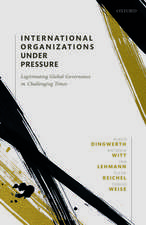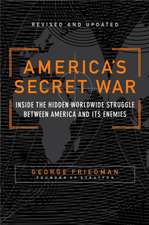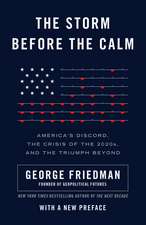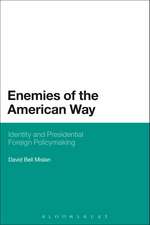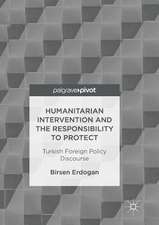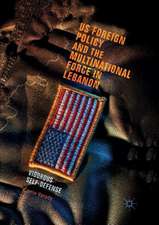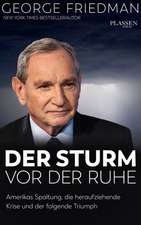The Next Decade: Anchor Books
Autor George Friedmanen Limba Engleză Paperback – 31 dec 2011
In the long view, history is seen as a series of events—but the course of those events is determined by individuals and their actions. During the next ten years, individual leaders will face significant transitions for their nations: the United States’ relationships with Iran and Israel will be undergoing changes, China will likely confront a major crisis, and the wars in the Islamic world will subside. Unexpected energy and technology developments will emerge, and labor shortages will begin to matter more than financial crises. Distinguished geopolitical forecaster George Friedman analyzes these events from the perspectives of the men and women leading these global changes, focusing in particular on the American president, who will require extraordinary skills to shepherd the United States through this transitional period. The Next Decade is a provocative and fascinating look at the conflicts and opportunities that lie ahead.
Din seria Anchor Books
-
 Preț: 107.22 lei
Preț: 107.22 lei -
 Preț: 83.71 lei
Preț: 83.71 lei -
 Preț: 72.17 lei
Preț: 72.17 lei -
 Preț: 96.71 lei
Preț: 96.71 lei -
 Preț: 108.42 lei
Preț: 108.42 lei -
 Preț: 81.56 lei
Preț: 81.56 lei -
 Preț: 89.50 lei
Preț: 89.50 lei -
 Preț: 81.71 lei
Preț: 81.71 lei -
 Preț: 91.54 lei
Preț: 91.54 lei -
 Preț: 59.05 lei
Preț: 59.05 lei -
 Preț: 117.24 lei
Preț: 117.24 lei -
 Preț: 66.59 lei
Preț: 66.59 lei -
 Preț: 128.89 lei
Preț: 128.89 lei - 13%
 Preț: 98.11 lei
Preț: 98.11 lei -
 Preț: 59.83 lei
Preț: 59.83 lei -
 Preț: 71.55 lei
Preț: 71.55 lei -
 Preț: 135.02 lei
Preț: 135.02 lei -
 Preț: 95.00 lei
Preț: 95.00 lei -
 Preț: 311.72 lei
Preț: 311.72 lei -
 Preț: 141.06 lei
Preț: 141.06 lei -
 Preț: 91.63 lei
Preț: 91.63 lei -
 Preț: 50.53 lei
Preț: 50.53 lei -
 Preț: 89.48 lei
Preț: 89.48 lei -
 Preț: 76.91 lei
Preț: 76.91 lei -
 Preț: 106.64 lei
Preț: 106.64 lei -
 Preț: 111.51 lei
Preț: 111.51 lei - 16%
 Preț: 79.33 lei
Preț: 79.33 lei -
 Preț: 70.46 lei
Preț: 70.46 lei -
 Preț: 88.88 lei
Preț: 88.88 lei -
 Preț: 54.84 lei
Preț: 54.84 lei -
 Preț: 64.09 lei
Preț: 64.09 lei -
 Preț: 89.03 lei
Preț: 89.03 lei -
 Preț: 92.23 lei
Preț: 92.23 lei -
 Preț: 123.46 lei
Preț: 123.46 lei -
 Preț: 91.38 lei
Preț: 91.38 lei - NaN%
 Preț: 78.83 lei
Preț: 78.83 lei -
 Preț: 144.11 lei
Preț: 144.11 lei -
 Preț: 115.65 lei
Preț: 115.65 lei -
 Preț: 91.57 lei
Preț: 91.57 lei -
 Preț: 94.88 lei
Preț: 94.88 lei -
 Preț: 81.42 lei
Preț: 81.42 lei -
 Preț: 91.13 lei
Preț: 91.13 lei -
 Preț: 135.88 lei
Preț: 135.88 lei -
 Preț: 80.43 lei
Preț: 80.43 lei -
 Preț: 91.55 lei
Preț: 91.55 lei -
 Preț: 92.99 lei
Preț: 92.99 lei -
 Preț: 81.66 lei
Preț: 81.66 lei -
 Preț: 89.06 lei
Preț: 89.06 lei
Preț: 100.73 lei
Nou
Puncte Express: 151
Preț estimativ în valută:
19.27€ • 20.18$ • 15.95£
19.27€ • 20.18$ • 15.95£
Carte disponibilă
Livrare economică 15-29 martie
Livrare express 01-07 martie pentru 21.18 lei
Preluare comenzi: 021 569.72.76
Specificații
ISBN-13: 9780307476395
ISBN-10: 0307476391
Pagini: 272
Dimensiuni: 130 x 201 x 23 mm
Greutate: 0.27 kg
Editura: Anchor Books
Colecția Anchor Books
Seria Anchor Books
ISBN-10: 0307476391
Pagini: 272
Dimensiuni: 130 x 201 x 23 mm
Greutate: 0.27 kg
Editura: Anchor Books
Colecția Anchor Books
Seria Anchor Books
Recenzii
“A must-read.” —The Washington Times
“Delivered in an engaging style and with no little dramatic flourish . . . [The Next Decade should] find a wide and receptive popular audience.” —San Francisco Chronicle
“Friedman . . . has the unusual ability to view events through the eyes of not only American but also foreign leaders.” —New York Observer
“There is a temptation, when you are around George Friedman, to treat him like a Magic 8-Ball.” —The New York Times Magazine
“Considering how right [Friedman]’s been over the years, he’s worth listening to.” —San Antonio Express-News
“Predictions have made George Friedman a hot property these days.” —The Wall Street Journal
“Well-researched and compelling.” —Publishers Weekly
“Expect the unexpected. . . . He can see without the crystal ball.” —Newsweek
“Delivered in an engaging style and with no little dramatic flourish . . . [The Next Decade should] find a wide and receptive popular audience.” —San Francisco Chronicle
“Friedman . . . has the unusual ability to view events through the eyes of not only American but also foreign leaders.” —New York Observer
“There is a temptation, when you are around George Friedman, to treat him like a Magic 8-Ball.” —The New York Times Magazine
“Considering how right [Friedman]’s been over the years, he’s worth listening to.” —San Antonio Express-News
“Predictions have made George Friedman a hot property these days.” —The Wall Street Journal
“Well-researched and compelling.” —Publishers Weekly
“Expect the unexpected. . . . He can see without the crystal ball.” —Newsweek
Extras
INTRODUCTION
Rebalancing America
A century is about events. A decade is about people. I wrote The Next 100 Years to explore the impersonal forces that shape history in the long run, but human beings don’t live in the long run. We live in the much shorter span in which our lives are shaped not so much by vast historical trends but by the specific decisions of specific individuals.
This book is about the short run of the next ten years: the specific realities to be faced, the specific decisions to be made, and the likely consequences of those decisions. Most people think that the longer the time frame, the more unpredictable the future. I take the opposite view. Individual actions are the hardest thing to predict. In the course of a century, so many individual decisions are made that no single one of them is ever critical. Each decision is lost in the torrent of judgments that make up a century. But in the shorter time frame of a decade, individual decisions made by individual people, particularly those with political power, can matter enormously. What I wrote in The Next 100 Years is the frame for understanding this decade. But it is only the frame.
Forecasting a century is the art of recognizing the impossible, then eliminating from consideration all the events that, at least logically, aren’t going to happen. The reason is, as Sherlock Holmes put it, “When you have eliminated the impossible, whatever remains, however improbable, must be the truth.”
It is always possible that a leader will do something unexpectedly foolish or brilliant, which is why forecasting is best left to the long run, the span over which individual decisions don’t carry so much weight. But having forecast for the long run, you can reel back your scenario and try to see how it plays out in, say, a decade. What makes this time frame interesting is that it is sufficiently long for the larger, impersonal forces to be at play but short enough for the individual decisions of individual leaders to skew outcomes that otherwise might seem inevitable. A decade is the point at which history and statesmanship meet, and a span in which policies still matter.
I am not normally someone who gets involved in policy debates— I’m more interested in what will happen than in what I want to see happen. But within the span of a decade, events that may not matter in the long run may still affect us personally and deeply. They also can have real meaning in defining which path we take into the future. This book is therefore both a forecast and a discussion of the policies that ought to be followed.
We begin with the United States for the same reason that a study of 1910 would have to begin with Britain. Whatever the future might hold, the global system today pivots around the United States, just as Britain was the pivotal point in the years leading up to World War I. In The Next 100 Years, I wrote about the long-term power of the United States. In this book, I have to write about American weaknesses, which, I think, are not problems in the long run; time will take care of most of these. But because you and I don’t live in the long run, for us these problems are very real. Most are rooted in structural imbalances that require solutions. Some are problems of leadership, because, as I said at the outset, a decade is about people.
This discussion of problems and people is particularly urgent at this introduction moment. In the first decade after the United States became the sole global power, the world was, compared to other eras, relatively tranquil. In terms of genuine security issues for the United States, Baghdad and the Balkans were nuisances, not threats. The United States had no need for strategy in a world that appeared to have accepted American leadership without complaint. Ten years later, September 11 brought that illusion crashing to the ground. The world was more dangerous than we imagined, but the options seemed fewer as well. The United States did not craft a global strategy in response. Instead, it developed a narrowly focused politico-military strategy designed to defeat terrorism, almost to the exclusion of all else.
Now that decade is coming to an end as well, and the search is under way for an exit from Iraq, from Afghanistan, and indeed from the world that began when those hijacked airliners smashed into buildings in New York and Washington. The impulse of the United States is always to withdraw from the world, savoring the pleasures of a secure homeland protected by the buffer of wide oceans on either side. But the homeland is not secure, either from terrorists or from the ambitions of nation-states that see the United States as both dangerous and unpredictable.
Under both President Bush and President Obama, the United States has lost sight of the long-term strategy that served it well for most of the last century. Instead, recent presidents have gone off on ad hoc adventures. They have set unattainable goals because they have framed the issues incorrectly, as if they believed their own rhetoric. As a result, the United States has overextended its ability to project its power around the world, which has allowed even minor players to be the tail that wags the dog.
The overriding necessity for American policy in the decade to come is a return to the balanced, global strategy that the United States learned from the example of ancient Rome and from the Britain of a hundred years ago. These old-school imperialists didn’t rule by main force. Instead, they maintained their dominance by setting regional players against each other and keeping these players in opposition to others who might also instigate resistance. They maintained the balance of power, using these opposing forces to cancel each other out while securing the broader interests of the empire. They also kept their client states bound together by economic interest and diplomacy, which is not to say the routine courtesies between nations but the subtle manipulation that causes neighbors and fellow clients to distrust each other more than they distrust the imperial powers. Direct intervention relying on the empire’s own troops was a distant, last resort.
Adhering to this strategy, the United States intervened in World War I only when the standoff among European powers was failing, and only when it appeared that the Germans, with Russia collapsing in the east, might actually overwhelm the English and French in the west. When the fighting stopped, the United States helped forge a peace treaty that prevented France from dominating postwar Europe.
During the early days of World War II, the United States stayed out of direct engagement as long as it could, supporting the British in their efforts to fend off the Germans in the west while encouraging the Soviets to bleed the Germans in the east. Afterward, the United States devised a balance-of-power strategy to prevent the Soviet Union from dominating Western Europe, the Middle East, and ultimately China. Throughout the long span from the first appearance of the “Iron Curtain” to the end of the Cold War, this U.S. strategy of distraction and manipulation was rational, coherent, and effectively devious.
Following the collapse of the Soviet Union, however, the United States shifted from a strategy focused on trying to contain major powers to an unfocused attempt to contain potential regional hegemons when their behavior offended American sensibilities. In the period from 1991 to 2001, the United States invaded or intervened in five countries—Kuwait, Somalia, Haiti, Bosnia, and Yugoslavia—which was an extraordinary tempo of military operations. At times, American strategy seemed to be driven by humanitarian concerns, although the goal was not always clear. In what sense, for example, was the 1994 invasion of Haiti in the national interest?
But the United States had an enormous reservoir of power in the 1990s, which gave it ample room for maneuver, as well as room for indulging its ideological whims. When you are overwhelmingly dominant, you don’t have to operate with a surgeon’s precision. Nor did the United States, when dealing with potential regional hegemons, have to win, in the sense of defeating an enemy army and occupying its homeland. From a military point of view, U.S. incursions during the 1990s were spoiling attacks, the immediate goal being to plunge an aspiring regional power into chaos, forcing it to deal with regional and internal threats at a time and place of American choosing rather than allowing it to develop and confront the United States on the smaller nation’s own schedule.
After September 11, 2001, a United States newly obsessed with terrorism became even more disoriented, losing sight of its long-term strategic principles altogether. As an alternative, it created a new but unattainable strategic goal, which was the elimination of the terrorist threat. The principal source of that threat, al Qaeda, had given itself an unlikely but not inconceivable objective, which was to re-create the Islamic caliphate, the theocracy that was established by Muhammad in the seventh century and that persisted in one form or another until the fall of the Ottoman Empire at the end of World War I. Al Qaeda’s strategy was to overthrow Muslim governments that it regarded as insufficiently Islamic, which it sought to do by fomenting popular uprisings in those countries. From al Qaeda’s point of view, the reason that the Islamic masses remained downtrodden was fear of their governments, which was in turn based on a sense that the United States, their governments’ patron, could not be challenged. To free the masses from their intimidation, al Qaeda felt that it had to demonstrate that the United States was not as powerful as it appeared—that it was in fact vulnerable to even a small group of Muslims, provided that those Muslims were prepared to die.
In response to al Qaeda’s assaults, the United States slammed into the Islamic world—particularly in Afghanistan and Iraq. The goal was to demonstrate U.S. capability and reach, but these efforts were once again spoiling attacks. Their purpose was not to defeat an army and occupy a territory but merely to disrupt al Qaeda and create chaos in the Muslim world. But creating chaos is a short-term tactic, not a long-term strategy. The United States demonstrated that it is possible to destroy terrorist organizations and mitigate terrorism, but it did not achieve the goal that it had articulated, which was to eliminate the threat altogether. Eliminating such a threat would require monitoring the private activities of more than a billion people spread across the globe. Even attempting such an effort would require overwhelming resources. And given that succeeding in such an effort is impossible, it is axiomatic that the United States would exhaust itself and run out of resources in the process, as has happened. Just because something like the elimination of terrorism is desirable doesn’t mean that it is practical, or that the price to be paid is rational.
Recovering from the depletions and distractions of this effort will consume the United States over the next ten years. The first step—returning to a policy of maintaining regional balances of power—must begin in the main area of current U.S. military engagement, a theater stretching from the Mediterranean to the Hindu Kush. For most of the past half century there have been three native balances of power here: the Arab-Israeli, the Indo-Pakistani, and the Iranian-Iraqi. Owing largely to recent U.S. policy, those balances are unstable or no longer exist. The Israelis are no longer constrained by their neighbors and are now trying to create a new reality on the ground. The Pakistanis have been badly weakened by the war in Afghanistan, and they are no longer an effective counterbalance to India. And, most important, the Iraqi state has collapsed, leaving the Iranians as the most powerful military force in the Persian Gulf area.
Restoring balance to that region, and then to U.S. policy more generally, will require steps during the next decade that will be seen as controversial, to say the least. As I argue in the chapters that follow, the United States must quietly distance itself from Israel. It must strengthen (or at least put an end to weakening) Pakistan. And in the spirit of Roosevelt’s entente with the USSR during World War II, as well as Nixon’s entente with China in the 1970s, the United States will be required to make a distasteful accommodation with Iran, regardless of whether it attacks Iran’s nuclear facilities. These steps will demand a more subtle exercise of power than we have seen on the part of recent presidents. The nature of that subtlety is a second major theme of the decade to come, and one that I will address further along.
While the Middle East is the starting point for America’s return to balance, Eurasia as a whole will also require a rearrangement of relationships. For generations, keeping the technological sophistication of Europe separated from the natural resources and manpower of Russia has been one of the key aims of American foreign policy. In the early 1990s, when the United States stood supreme and Moscow lost control over not only the former Soviet Union but the Russian state as well, that goal was neglected. Almost immediately after September 11, 2001, the unbalanced commitment of U.S. forces to the Mediterranean-Himalayan theater created a window of opportunity for the Russian security apparatus to regain its influence. Under Putin, the Russians began to reassert themselves even prior to the war with Georgia, and they have accelerated the process of their reemergence since. Diverted and tied down in Iraq and Afghanistan, the United States has been unable to hold back Moscow’s return to influence, or even to make credible threats that would inhibit Russian ambitions. As a result, the United States now faces a significant regional power with its own divergent agenda, which includes a play for influence in Europe.
The danger of Russia’s reemergence and westward focus will become more obvious as we examine the other player in this second region of concern, the European Union. Once imagined as a supernation on the order of the United States, the EU began to show its structural weaknesses during the financial crisis of 2008, which led to the follow-on crisis of southern European economies (Italy, Spain, Portugal, and Greece). Once Germany, the EU’s greatest economic engine, faced the prospect of underwriting the mistakes and excesses of its EU partners, it began to reexamine its priorities. The emerging conclusion is that Germany potentially shared a greater community of interest with Russia than it did with its European neighbors. However much Germany might benefit from economic alliances in Europe, it remains dependent on Russia for a large amount of its natural gas. Russia in turn needs technology, which Germany has in abundance. Similarly, Germany needs an infusion of manpower that isn’t going to create social stresses by emigration to Germany, and one obvious solution is to establish German factories in Russia. Meanwhile, America’s request for increased German help in Afghanistan and elsewhere has created friction with the United States and aligned German interests most closely with Russia.
All of which helps to explain why the United States’ return to balance will require a significant effort over the next decade to block an accommodation between Germany and Russia. As we will see, the U.S. approach will include cultivating a new relationship with Poland, the geographic monkey wrench that can be thrown into the gears of a German-Russian entente.
China, of course, also demands attention. Even so, the current preoccupation with Chinese expansion will diminish as that country’s economic miracle comes of age. China’s economic performance will slow to that of a more mature economy—and, we might add, a more mature economy with over a billion people living in abject poverty. The focus of U.S. efforts will shift to the real power in northeast Asia: Japan, the third largest economy in the world and the nation with the most significant navy in the region. As this brief overview already suggests, the next ten years will be enormously complex, with many moving parts and many unpredictable elements. The presidents in the decade to come will have to reconcile American traditions and moral principles with realities that most Americans find it more comfortable to avoid. This will require the execution of demanding maneuvers, including allying with enemies, while holding together a public that believes—and wants to believe—that foreign policy and values simply coincide. The president will have to pursue virtue as all of our great presidents have done: with suitable duplicity.
But all the cleverness in the world can’t compensate for profound weakness. The United States possesses what I call “deep power,” and deep power must be first and foremost balanced power. This means economic, military, and political power in appropriate and mutually supporting amounts. It is deep in a second sense, which is that it rests on a foundation of cultural and ethical norms that define how that power is to be used and that provides a framework for individual action. Europe, for example, has economic power, but it is militarily weak and rests on a very shallow foundation. There is little consensus in Europe politically, particularly about the framework of obligations imposed on its members.
Power that is both deeply rooted and well balanced is rare, and I will try to show that in the next decade, the United States is uniquely situated to consolidate and exercise both. More important, it will have little choice in the matter. There is an idea, both on the left and on the right, that the United States has the option of withdrawing from the complexities of managing global power. It’s the belief that if the United States ceased to meddle in the affairs of the world, the world would no longer hate and fear it, and Americans could enjoy their pleasures without fear of attack. This belief is nostalgia for a time when the United States pursued its own interests at home and left the world to follow its own course.
There was indeed a time when Thomas Jefferson could warn against entangling alliances, but this was not a time when the United States annually produced 25 percent of the wealth of the world. That output alone entangles it in the affairs of the world. What the United States consumes and produces shapes the lives of people around the world. The economic policies pursued by the United States shape the economic realities of the world. The U.S. Navy’s control of the seas guarantees the United States economic access to the world and gives it the potential power to deny that access to other countries. Even if the United States wanted to shrink its economy to a less intrusive size, it is not clear how that would be done, let alone that Americans would pay the price when the bill was presented.
But this does not mean that the United States is at ease with its power. Things have moved too far too fast. That is why bringing U.S. policy back into balance will also require bringing the United States to terms with its actual place in the world. We have already noted that the fall of the Soviet Union left the United States without a rival for global dominance. What needs to be faced squarely now is that whether we like it or not, and whether it was intentional or not, the United States emerged from the Cold War not only as the global hegemon but as a global empire.
The reality is that the American people have no desire for an empire. This is not to say that they don’t want the benefits, both economic and strategic. It simply means that they don’t want to pay the price. Economically, Americans want the growth potential of open markets but not the pains. Politically, they want to have enormous influence but not the resentment of the world. Militarily, they want to be protected from dangers but not to bear the burdens of a long-term strategy.
Empires are rarely planned or premeditated, and those that have been, such as Napoleon’s and Hitler’s, tend not to last. Those that endure grow organically, and their imperial status often goes unnoticed until it has become overwhelming. This was the case both for Rome and for Britain, yet they succeeded because once they achieved imperial status, they not only owned up to it, they learned to manage it.
Unlike the Roman or British Empire, the American structure of dominance is informal, but that makes it no less real. The United States controls the oceans, and its economy accounts for more than a quarter of everything produced in the world. If Americans adopt the iPod or a new food fad, factories and farms in China and Latin America reorganize to serve the new mandate. This is how the European powers governed China in the nineteenth century—never formally, but by shaping and exploiting it to the degree that the distinction between formal and informal hardly mattered.
A fact that the American people have trouble assimilating is that the size and power of the American empire is inherently disruptive and intrusive, which means that the United States can rarely take a step without threatening some nation or benefiting another. While such power confers enormous economic advantages, it naturally engenders hostility. The United States is a commercial republic, which means that it lives on trade. Its tremendous prosperity derives from its own assets and virtues, but it cannot maintain this prosperity and be isolated from the world. Therefore, if the United States intends to retain its size, wealth, and power, the only option is to learn how to manage its disruptive influence maturely.
Until the empire is recognized for what it is, it is difficult to have a coherent public discussion of its usefulness, its painfulness, and, above all, its inevitability. Unrivaled power is dangerous enough, but unrivaled power that is oblivious is like a rampaging elephant.
I will argue, then, that the next decade must be one in which the United States moves from willful ignorance of reality to its acceptance, however reluctant. With that acceptance will come the beginning of a more sophisticated foreign policy. There will be no proclamation of empire, only more effective management based on the underlying truth of the situation.
Rebalancing America
A century is about events. A decade is about people. I wrote The Next 100 Years to explore the impersonal forces that shape history in the long run, but human beings don’t live in the long run. We live in the much shorter span in which our lives are shaped not so much by vast historical trends but by the specific decisions of specific individuals.
This book is about the short run of the next ten years: the specific realities to be faced, the specific decisions to be made, and the likely consequences of those decisions. Most people think that the longer the time frame, the more unpredictable the future. I take the opposite view. Individual actions are the hardest thing to predict. In the course of a century, so many individual decisions are made that no single one of them is ever critical. Each decision is lost in the torrent of judgments that make up a century. But in the shorter time frame of a decade, individual decisions made by individual people, particularly those with political power, can matter enormously. What I wrote in The Next 100 Years is the frame for understanding this decade. But it is only the frame.
Forecasting a century is the art of recognizing the impossible, then eliminating from consideration all the events that, at least logically, aren’t going to happen. The reason is, as Sherlock Holmes put it, “When you have eliminated the impossible, whatever remains, however improbable, must be the truth.”
It is always possible that a leader will do something unexpectedly foolish or brilliant, which is why forecasting is best left to the long run, the span over which individual decisions don’t carry so much weight. But having forecast for the long run, you can reel back your scenario and try to see how it plays out in, say, a decade. What makes this time frame interesting is that it is sufficiently long for the larger, impersonal forces to be at play but short enough for the individual decisions of individual leaders to skew outcomes that otherwise might seem inevitable. A decade is the point at which history and statesmanship meet, and a span in which policies still matter.
I am not normally someone who gets involved in policy debates— I’m more interested in what will happen than in what I want to see happen. But within the span of a decade, events that may not matter in the long run may still affect us personally and deeply. They also can have real meaning in defining which path we take into the future. This book is therefore both a forecast and a discussion of the policies that ought to be followed.
We begin with the United States for the same reason that a study of 1910 would have to begin with Britain. Whatever the future might hold, the global system today pivots around the United States, just as Britain was the pivotal point in the years leading up to World War I. In The Next 100 Years, I wrote about the long-term power of the United States. In this book, I have to write about American weaknesses, which, I think, are not problems in the long run; time will take care of most of these. But because you and I don’t live in the long run, for us these problems are very real. Most are rooted in structural imbalances that require solutions. Some are problems of leadership, because, as I said at the outset, a decade is about people.
This discussion of problems and people is particularly urgent at this introduction moment. In the first decade after the United States became the sole global power, the world was, compared to other eras, relatively tranquil. In terms of genuine security issues for the United States, Baghdad and the Balkans were nuisances, not threats. The United States had no need for strategy in a world that appeared to have accepted American leadership without complaint. Ten years later, September 11 brought that illusion crashing to the ground. The world was more dangerous than we imagined, but the options seemed fewer as well. The United States did not craft a global strategy in response. Instead, it developed a narrowly focused politico-military strategy designed to defeat terrorism, almost to the exclusion of all else.
Now that decade is coming to an end as well, and the search is under way for an exit from Iraq, from Afghanistan, and indeed from the world that began when those hijacked airliners smashed into buildings in New York and Washington. The impulse of the United States is always to withdraw from the world, savoring the pleasures of a secure homeland protected by the buffer of wide oceans on either side. But the homeland is not secure, either from terrorists or from the ambitions of nation-states that see the United States as both dangerous and unpredictable.
Under both President Bush and President Obama, the United States has lost sight of the long-term strategy that served it well for most of the last century. Instead, recent presidents have gone off on ad hoc adventures. They have set unattainable goals because they have framed the issues incorrectly, as if they believed their own rhetoric. As a result, the United States has overextended its ability to project its power around the world, which has allowed even minor players to be the tail that wags the dog.
The overriding necessity for American policy in the decade to come is a return to the balanced, global strategy that the United States learned from the example of ancient Rome and from the Britain of a hundred years ago. These old-school imperialists didn’t rule by main force. Instead, they maintained their dominance by setting regional players against each other and keeping these players in opposition to others who might also instigate resistance. They maintained the balance of power, using these opposing forces to cancel each other out while securing the broader interests of the empire. They also kept their client states bound together by economic interest and diplomacy, which is not to say the routine courtesies between nations but the subtle manipulation that causes neighbors and fellow clients to distrust each other more than they distrust the imperial powers. Direct intervention relying on the empire’s own troops was a distant, last resort.
Adhering to this strategy, the United States intervened in World War I only when the standoff among European powers was failing, and only when it appeared that the Germans, with Russia collapsing in the east, might actually overwhelm the English and French in the west. When the fighting stopped, the United States helped forge a peace treaty that prevented France from dominating postwar Europe.
During the early days of World War II, the United States stayed out of direct engagement as long as it could, supporting the British in their efforts to fend off the Germans in the west while encouraging the Soviets to bleed the Germans in the east. Afterward, the United States devised a balance-of-power strategy to prevent the Soviet Union from dominating Western Europe, the Middle East, and ultimately China. Throughout the long span from the first appearance of the “Iron Curtain” to the end of the Cold War, this U.S. strategy of distraction and manipulation was rational, coherent, and effectively devious.
Following the collapse of the Soviet Union, however, the United States shifted from a strategy focused on trying to contain major powers to an unfocused attempt to contain potential regional hegemons when their behavior offended American sensibilities. In the period from 1991 to 2001, the United States invaded or intervened in five countries—Kuwait, Somalia, Haiti, Bosnia, and Yugoslavia—which was an extraordinary tempo of military operations. At times, American strategy seemed to be driven by humanitarian concerns, although the goal was not always clear. In what sense, for example, was the 1994 invasion of Haiti in the national interest?
But the United States had an enormous reservoir of power in the 1990s, which gave it ample room for maneuver, as well as room for indulging its ideological whims. When you are overwhelmingly dominant, you don’t have to operate with a surgeon’s precision. Nor did the United States, when dealing with potential regional hegemons, have to win, in the sense of defeating an enemy army and occupying its homeland. From a military point of view, U.S. incursions during the 1990s were spoiling attacks, the immediate goal being to plunge an aspiring regional power into chaos, forcing it to deal with regional and internal threats at a time and place of American choosing rather than allowing it to develop and confront the United States on the smaller nation’s own schedule.
After September 11, 2001, a United States newly obsessed with terrorism became even more disoriented, losing sight of its long-term strategic principles altogether. As an alternative, it created a new but unattainable strategic goal, which was the elimination of the terrorist threat. The principal source of that threat, al Qaeda, had given itself an unlikely but not inconceivable objective, which was to re-create the Islamic caliphate, the theocracy that was established by Muhammad in the seventh century and that persisted in one form or another until the fall of the Ottoman Empire at the end of World War I. Al Qaeda’s strategy was to overthrow Muslim governments that it regarded as insufficiently Islamic, which it sought to do by fomenting popular uprisings in those countries. From al Qaeda’s point of view, the reason that the Islamic masses remained downtrodden was fear of their governments, which was in turn based on a sense that the United States, their governments’ patron, could not be challenged. To free the masses from their intimidation, al Qaeda felt that it had to demonstrate that the United States was not as powerful as it appeared—that it was in fact vulnerable to even a small group of Muslims, provided that those Muslims were prepared to die.
In response to al Qaeda’s assaults, the United States slammed into the Islamic world—particularly in Afghanistan and Iraq. The goal was to demonstrate U.S. capability and reach, but these efforts were once again spoiling attacks. Their purpose was not to defeat an army and occupy a territory but merely to disrupt al Qaeda and create chaos in the Muslim world. But creating chaos is a short-term tactic, not a long-term strategy. The United States demonstrated that it is possible to destroy terrorist organizations and mitigate terrorism, but it did not achieve the goal that it had articulated, which was to eliminate the threat altogether. Eliminating such a threat would require monitoring the private activities of more than a billion people spread across the globe. Even attempting such an effort would require overwhelming resources. And given that succeeding in such an effort is impossible, it is axiomatic that the United States would exhaust itself and run out of resources in the process, as has happened. Just because something like the elimination of terrorism is desirable doesn’t mean that it is practical, or that the price to be paid is rational.
Recovering from the depletions and distractions of this effort will consume the United States over the next ten years. The first step—returning to a policy of maintaining regional balances of power—must begin in the main area of current U.S. military engagement, a theater stretching from the Mediterranean to the Hindu Kush. For most of the past half century there have been three native balances of power here: the Arab-Israeli, the Indo-Pakistani, and the Iranian-Iraqi. Owing largely to recent U.S. policy, those balances are unstable or no longer exist. The Israelis are no longer constrained by their neighbors and are now trying to create a new reality on the ground. The Pakistanis have been badly weakened by the war in Afghanistan, and they are no longer an effective counterbalance to India. And, most important, the Iraqi state has collapsed, leaving the Iranians as the most powerful military force in the Persian Gulf area.
Restoring balance to that region, and then to U.S. policy more generally, will require steps during the next decade that will be seen as controversial, to say the least. As I argue in the chapters that follow, the United States must quietly distance itself from Israel. It must strengthen (or at least put an end to weakening) Pakistan. And in the spirit of Roosevelt’s entente with the USSR during World War II, as well as Nixon’s entente with China in the 1970s, the United States will be required to make a distasteful accommodation with Iran, regardless of whether it attacks Iran’s nuclear facilities. These steps will demand a more subtle exercise of power than we have seen on the part of recent presidents. The nature of that subtlety is a second major theme of the decade to come, and one that I will address further along.
While the Middle East is the starting point for America’s return to balance, Eurasia as a whole will also require a rearrangement of relationships. For generations, keeping the technological sophistication of Europe separated from the natural resources and manpower of Russia has been one of the key aims of American foreign policy. In the early 1990s, when the United States stood supreme and Moscow lost control over not only the former Soviet Union but the Russian state as well, that goal was neglected. Almost immediately after September 11, 2001, the unbalanced commitment of U.S. forces to the Mediterranean-Himalayan theater created a window of opportunity for the Russian security apparatus to regain its influence. Under Putin, the Russians began to reassert themselves even prior to the war with Georgia, and they have accelerated the process of their reemergence since. Diverted and tied down in Iraq and Afghanistan, the United States has been unable to hold back Moscow’s return to influence, or even to make credible threats that would inhibit Russian ambitions. As a result, the United States now faces a significant regional power with its own divergent agenda, which includes a play for influence in Europe.
The danger of Russia’s reemergence and westward focus will become more obvious as we examine the other player in this second region of concern, the European Union. Once imagined as a supernation on the order of the United States, the EU began to show its structural weaknesses during the financial crisis of 2008, which led to the follow-on crisis of southern European economies (Italy, Spain, Portugal, and Greece). Once Germany, the EU’s greatest economic engine, faced the prospect of underwriting the mistakes and excesses of its EU partners, it began to reexamine its priorities. The emerging conclusion is that Germany potentially shared a greater community of interest with Russia than it did with its European neighbors. However much Germany might benefit from economic alliances in Europe, it remains dependent on Russia for a large amount of its natural gas. Russia in turn needs technology, which Germany has in abundance. Similarly, Germany needs an infusion of manpower that isn’t going to create social stresses by emigration to Germany, and one obvious solution is to establish German factories in Russia. Meanwhile, America’s request for increased German help in Afghanistan and elsewhere has created friction with the United States and aligned German interests most closely with Russia.
All of which helps to explain why the United States’ return to balance will require a significant effort over the next decade to block an accommodation between Germany and Russia. As we will see, the U.S. approach will include cultivating a new relationship with Poland, the geographic monkey wrench that can be thrown into the gears of a German-Russian entente.
China, of course, also demands attention. Even so, the current preoccupation with Chinese expansion will diminish as that country’s economic miracle comes of age. China’s economic performance will slow to that of a more mature economy—and, we might add, a more mature economy with over a billion people living in abject poverty. The focus of U.S. efforts will shift to the real power in northeast Asia: Japan, the third largest economy in the world and the nation with the most significant navy in the region. As this brief overview already suggests, the next ten years will be enormously complex, with many moving parts and many unpredictable elements. The presidents in the decade to come will have to reconcile American traditions and moral principles with realities that most Americans find it more comfortable to avoid. This will require the execution of demanding maneuvers, including allying with enemies, while holding together a public that believes—and wants to believe—that foreign policy and values simply coincide. The president will have to pursue virtue as all of our great presidents have done: with suitable duplicity.
But all the cleverness in the world can’t compensate for profound weakness. The United States possesses what I call “deep power,” and deep power must be first and foremost balanced power. This means economic, military, and political power in appropriate and mutually supporting amounts. It is deep in a second sense, which is that it rests on a foundation of cultural and ethical norms that define how that power is to be used and that provides a framework for individual action. Europe, for example, has economic power, but it is militarily weak and rests on a very shallow foundation. There is little consensus in Europe politically, particularly about the framework of obligations imposed on its members.
Power that is both deeply rooted and well balanced is rare, and I will try to show that in the next decade, the United States is uniquely situated to consolidate and exercise both. More important, it will have little choice in the matter. There is an idea, both on the left and on the right, that the United States has the option of withdrawing from the complexities of managing global power. It’s the belief that if the United States ceased to meddle in the affairs of the world, the world would no longer hate and fear it, and Americans could enjoy their pleasures without fear of attack. This belief is nostalgia for a time when the United States pursued its own interests at home and left the world to follow its own course.
There was indeed a time when Thomas Jefferson could warn against entangling alliances, but this was not a time when the United States annually produced 25 percent of the wealth of the world. That output alone entangles it in the affairs of the world. What the United States consumes and produces shapes the lives of people around the world. The economic policies pursued by the United States shape the economic realities of the world. The U.S. Navy’s control of the seas guarantees the United States economic access to the world and gives it the potential power to deny that access to other countries. Even if the United States wanted to shrink its economy to a less intrusive size, it is not clear how that would be done, let alone that Americans would pay the price when the bill was presented.
But this does not mean that the United States is at ease with its power. Things have moved too far too fast. That is why bringing U.S. policy back into balance will also require bringing the United States to terms with its actual place in the world. We have already noted that the fall of the Soviet Union left the United States without a rival for global dominance. What needs to be faced squarely now is that whether we like it or not, and whether it was intentional or not, the United States emerged from the Cold War not only as the global hegemon but as a global empire.
The reality is that the American people have no desire for an empire. This is not to say that they don’t want the benefits, both economic and strategic. It simply means that they don’t want to pay the price. Economically, Americans want the growth potential of open markets but not the pains. Politically, they want to have enormous influence but not the resentment of the world. Militarily, they want to be protected from dangers but not to bear the burdens of a long-term strategy.
Empires are rarely planned or premeditated, and those that have been, such as Napoleon’s and Hitler’s, tend not to last. Those that endure grow organically, and their imperial status often goes unnoticed until it has become overwhelming. This was the case both for Rome and for Britain, yet they succeeded because once they achieved imperial status, they not only owned up to it, they learned to manage it.
Unlike the Roman or British Empire, the American structure of dominance is informal, but that makes it no less real. The United States controls the oceans, and its economy accounts for more than a quarter of everything produced in the world. If Americans adopt the iPod or a new food fad, factories and farms in China and Latin America reorganize to serve the new mandate. This is how the European powers governed China in the nineteenth century—never formally, but by shaping and exploiting it to the degree that the distinction between formal and informal hardly mattered.
A fact that the American people have trouble assimilating is that the size and power of the American empire is inherently disruptive and intrusive, which means that the United States can rarely take a step without threatening some nation or benefiting another. While such power confers enormous economic advantages, it naturally engenders hostility. The United States is a commercial republic, which means that it lives on trade. Its tremendous prosperity derives from its own assets and virtues, but it cannot maintain this prosperity and be isolated from the world. Therefore, if the United States intends to retain its size, wealth, and power, the only option is to learn how to manage its disruptive influence maturely.
Until the empire is recognized for what it is, it is difficult to have a coherent public discussion of its usefulness, its painfulness, and, above all, its inevitability. Unrivaled power is dangerous enough, but unrivaled power that is oblivious is like a rampaging elephant.
I will argue, then, that the next decade must be one in which the United States moves from willful ignorance of reality to its acceptance, however reluctant. With that acceptance will come the beginning of a more sophisticated foreign policy. There will be no proclamation of empire, only more effective management based on the underlying truth of the situation.
Notă biografică
George Friedman is the CEO and founder of Stratfor, the world’s leading private intelligence company. He is frequently called upon as a media expert in intelligence and international geopolitics, and is the author of six books, including the New York Times bestseller The Next 100 Years, as well as numerous articles on national security, information warfare, and the intelligence business. He lives in Austin, Texas.
Descriere
The author of the acclaimed "New York Times" bestseller "The Next 100 Years" now focuses his geopolitical forecasting acumen on the next decade and the imminent events and challenges that will test America and the world, specifically addressing the skills that will be required by the decade's leaders.




